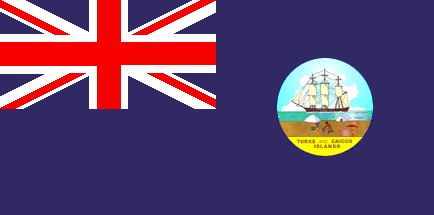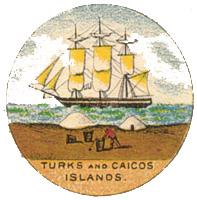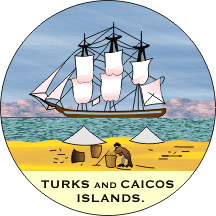Tropical Parad-Ice
The islands of Turks and Caicos are located in the Atlantic just north of the Caribbean Sea and, by and large, have pretty fantastic weather. Temperatures hit the low 70s (Fahrenheit) in the winter and peak in the high 80s in the summer, which is to say that in general, the islands are as tropical as their location would suggest. Certainly, it rarely gets cold there, and snow is unheard of.
Which makes its now-antiquated flag a bit weird — because there was an igloo on it.
From 1889 until 1968, the official flag of Turks and Caicos looked like this:

The flag follows a standard pattern of places that, at the time, were under British control. (Turks and Caicos is still under British rule as a British Overseas Territory.) If you look at the flags of the Bahamas, Jamaica, or Samoa while they were British colonies, you’ll notice a similar design — the Union Jack in the upper left and the region’s official colonial badge in the center-right. It’s not so easy to tell, but the badge on the Turks and Caicos flag — at least, as it appeared on the flag itself — featured our mysterious igloo. Zooming in on the badge on the Turks and Caicos flag, you’ll see it pretty quickly:

Putting aside that the colors are off — blame the lack of options in a Google Image search — you’ll see that the white hut on the right has a door. That, of course, makes no sense; there’s nothing even remotely resembling snow on these tropical islands. So what happened? Let’s start with what the colonial badge actually looked like at the time. It’s pictured below.

Everything (coloring aside) is the same — but now, the igloos on the beach have no doors. Nor should they, because they’re not igloos. They’re piles of salt. That’s consistent with the history of the Turks and Caicos. As Wikipedia notes, the processing of sea salt was a major factor in the early settlement of the islands by Europeans. The badge is a reference to this industry, and the white things are salt, not ice.
But in transferring the design to the flag, someone made a mistake. Over the years, the UK published something called the Admiralty Flag Book, which (among other things) dictated what the flags of overseas territories should look like. As the Times of the Islands (a Turks and Caicos publication) explains, in 1889, the artist who drew the Turks and Caicos flag for the Flag Book “mistakenly thought [the salt piles] were buildings (or igloos) and inserted a doorway into one of the heaps.” As a result, the official flag of these tropical islands had an accidental igloo on it for nearly eighty years.
In 1968, Turks and Caicos adopted a coat of arms which replaced the badge on its now-current flag, seen here. It features a conch horn, a lobster, and an indigenous cactus — and no Arctic abode (or salt).
Bonus Fact: The general design of the flag used by Turks and Caicos, the Bahamas, Australia, and many other areas with ties to the UK is called a “defaced blue ensign.” That sounds nefarious but isn’t. The British Blue Ensign is simply a blue flag with the Union Jack in the upper-left, and “defacement” in vexillology (that’s the study of flags) simply means that the flag has an additional symbol on it. There’s nothing in the term that implies that the flag has been desecrated.
From the Archives: The First American Flag Was Very British Looking: A very early Now I Know, about the earliest U.S. flag.
Take the Quiz: Click the islands that are part of the UK.
